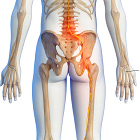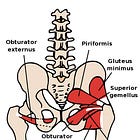Sciatica and Tight Hamstrings? STOP Stretching!
An example of how our perceptions can play tricks on us and sometimes the "solution" is actually part of the problem.
In this article:
Why stretching seems to help some and not others.
Why stretching can make you worse.
Why stretching is usually a bad idea for those with sciatica.
How to assess if you should avoid stretching.
If you have found this article, I'm sure you have also come across a myriad of other sciatica related articles online. Many of these probably mention a particular stretch that is supposed to "treat" your "sciatica".
Check out this article to find out why I am using the quotation marks above.
A small proportion of you reading this will have had great success with these stretches.
For many of you, stretching may have seemed to help a little initially but doesn't seem to improve things in the long run.
For the remainder of you, any attempt to perform these stretches quickly stirs up your symptoms and you just can't find any way to stretch without it causing more problems that it solves.
For the overwhelming majority of sciatica sufferers, stretching is more likely to be harmful than helpful. Lets breakdown each of the above scenarios to understand why.

1. The Therapeutic Stretchers
If you suffer from sciatica and have found stretching has provided you with lasting relief that has contributed to long term improved therapeutic outcomes, you are in the minority. An overwhelming minority in fact.
If this is you, I would wager a guess that your sciatica has little to do with any issue in your spine. For many of you, your sciatica may have been caused by an issue known as piriformis syndrome. And more specifically, piriformis syndrome caused by an overly tight piriformis muscle. However, this is a rare condition that is often misdiagnosed.
If you have had great success in treating sciatica with a stretch that targeted something other than your piriformis, I would love to hear about it.
2. Temporary Relief...Maybe?
Stretching is commonly promoted as a generally healthful practice. Due to these preconceptions, many people suffering from various injuries are under the belief that they should definitely be stretching to help their recovery. This is often the case when people develop sciatica.
Unfortunately, as I have already indicated, stretching is not always the answer. And sometimes it's counterproductive.
Why is it then so common for people with sciatica to be told they should stretch?
Well, there are a couple of reasons. The second of which I will get to later. The first however, can often create a vicious feedback in which our own actions keep us sensitized and in pain.
Our 'stretch reflex' is responsible for giving us the false feedback that stretching is providing us with benefit. While in fact a lot of the time, it is actually increasing our pain sensitivity.
The stretch reflex refers to an increase in neurological activity that occurs in response to a muscle being stretched. This feeds back to the muscles causing them to contract. This contraction prevents our muscles from over-stretching beyond their limits and causing damage like leading to a joint hyperextending for example.
However, it also has an analgesic (pain relieving) effect as it dulls the pain signal temporarily. This may seem like a good thing, however we commonly stretch into postures that actually aggravate lumbar spine pathologies and dull the signal telling us we shouldn't be doing it. It provides a false feedback loop in which the temporary pain relief encourages us to stretch more, only to further irritate our injury making us feel we need to stretch again
So if stretching seems to provide you with only temporary relief and you find your symptoms return just as bad (or worse) once the effects of this reflex have worn off, this is the reason.
But why oh why does it feel it like I need to stretch so badly? Why do my muscles feel so tight!
Our next subgroup will make this phenomenon clear.
3. The Painful Stretchers
Now for the group that can't handle stretching at all. They often feel a sensation of tightness somewhere along the sciatic nerves distribution (back, butt, hamstrings, calves, etc). But quickly discover that stretching causes more tension and pain and only serves to wind up their symptoms.
The reason this occurs is the same reason the overwhelming majority of sciatica sufferers do not benefit from the stretches they often think they require.
The feeling of "tightness" you experience in your legs, is not muscular tension at all, but rather increased “neural tension”.
Understanding neural tension is the key to overcoming the false pre-conceptions hoisted on your by the industry as well the unfortunate idiosyncrasy of our bodies own systems providing you with the false feedback that something harmful is actually helpful.
So that feeling of tightness is not in the muscle at all. It's in the sciatic nerve itself. When you stretch a muscle along the sciatic nerve's distribution, you're not only stretching the muscle, you also stretch the sciatic nerve.
When the sciatic nerve is irritated as a result of an injury in the lumbar spine, stretching and tensioning it only serves to further irritate it. Additionally, stretching the muscles in your leg usually does nothing to solve the injury in your spine that is creating these symptoms in the first place.
Those sciatica sufferers with very wound up and irritated sciatic nerves often can't handle any amount of additional tension on the sciatic nerve. Pushing through the pain to perhaps receive some temporary relief from activating the stretch reflex can become too painful to even attempt.
This group is the "canary in the coal mine" for those with less significant neural tension issues. Let this group be the clear example of why you shouldn't be stretching an irritated sciatic nerve.
So, how do you know if your problem is neural tension or muscular tightness?
Well, if you have sciatica the odds are in favor of neural tension being your problem. Regardless, I am going to describe the assessment I use to distinguish if neural tension or muscular tightness is the issue.
(You will need a partner to help you with this one).
Keep reading with a 7-day free trial
Subscribe to Back to Comfort: Your Back Pain Questions Answered to keep reading this post and get 7 days of free access to the full post archives.




